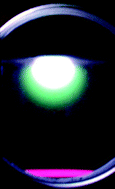A previously described instrument was used to obtain axial profiles of the gas-kinetic temperature (Tg) in a ms-pulsed glow discharge via Rayleigh scattering. In addition, the electron number density (ne) and the electron temperature (Te) were observed via Thomson scattering. For these measurements, the detection optics of the original instrument were modified and a photon-counting imaging technique was employed to allow the simultaneous observation of Thomson scattering from multiple spatial positions. It was found that the cell pressure and electrical characteristics of the glow-discharge pulse have an effect on the temporal behavior of all fundamental parameters. As with a dc glow discharge, there were two distinct classes of electrons, a high-energy group and a lower-energy (thermalized) group. The thermalized electrons showed greater energies during the prepeak than at the plateau. Following the power pulse, during the afterglow, ne and Te declined monotonically at the temporal and spatial positions observed. The spatial differences in ne during the afterglow are discussed with regards to the spatial variations in argon metastable population.

You have access to this article
 Please wait while we load your content...
Something went wrong. Try again?
Please wait while we load your content...
Something went wrong. Try again?


 Please wait while we load your content...
Please wait while we load your content...